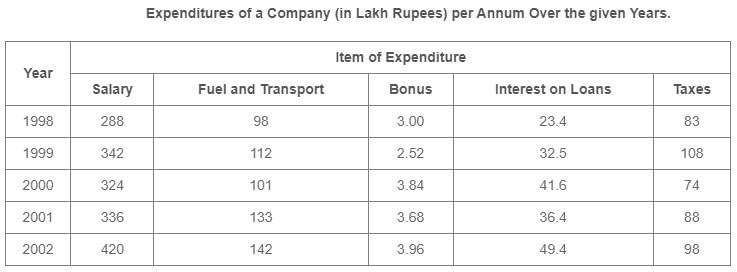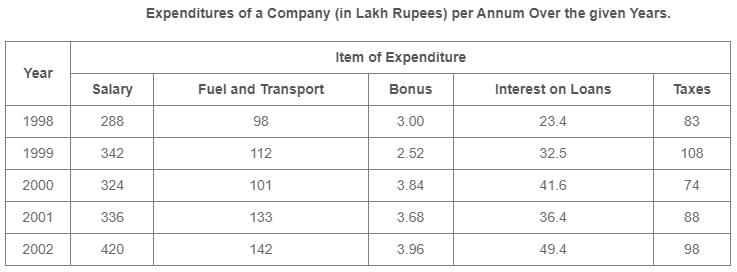MCQ: Table Charts - 1 - SSC CGL MCQ
15 Questions MCQ Test - MCQ: Table Charts - 1
Study the following table and answer the questions.
Classification of 100 Students Based on the Marks Obtained by them in Physics and Chemistry in an Examination.

Q. The percentage of number of students getting at least 60% marks in Chemistry over those getting at least 40% marks in aggregate, is approximately?
Classification of 100 Students Based on the Marks Obtained by them in Physics and Chemistry in an Examination.

Study the following table and answer the questions.
Classification of 100 Students Based on the Marks Obtained by them in Physics and Chemistry in an Examination.

Q. If at least 60% marks in Physics are required for pursuing higher studies in Physics, how many students will be eligible to pursue higher studies in Physics?
Classification of 100 Students Based on the Marks Obtained by them in Physics and Chemistry in an Examination.

Study the following table and answer the questions.
Classification of 100 Students Based on the Marks Obtained by them in Physics and Chemistry in an Examination.

Q. The number of students scoring less than 40% marks in aggregate is?
Classification of 100 Students Based on the Marks Obtained by them in Physics and Chemistry in an Examination.

Study the following table and answer the questions.
Classification of 100 Students Based on the Marks Obtained by them in Physics and Chemistry in an Examination.

Q. If it is known that at least 23 students were eligible for a Symposium on Chemistry, then the minimum qualifying marks in Chemistry for eligibility to Symposium would lie in the range?
Study the following table and answer the questions.
Classification of 100 Students Based on the Marks Obtained by them in Physics and Chemistry in an Examination.

Q. What is the different between the number of students passed with 30 as cut-off marks in Chemistry and those passed with 30 as cut-off marks in aggregate?
Study the following table and answer the questions based on it.

Q. The ratio between the total expenditure on Taxes for all the years and the total expenditure on Fuel and Transport for all the years respectively is approximately?
Study the following table and answer the questions based on it.

Q. Total expenditure on all these items in 1998 was approximately what percent of the total expenditure in 2002?
Study the following table and answer the questions based on it.

Q. The total expenditure of the company over these items during the year 2000 is?
Study the following table and answer the questions based on it.

Q. The total amount of bonus paid by the company during the given period is approximately what percent of the total amount of salary paid during this period?
Study the following table and answer the questions based on it.

Q. What is the average amount of interest per year which the company had to pay during this period?
The following table gives the sales of batteries manufactured by a company over the years.

Q. The percentage of 4AH batteries sold to the total number of batteries sold was maximum in the year?
The following table gives the sales of batteries manufactured by a company over the years.

Q. In case of which battery there was a continuous decrease in sales from 1992 to 1997?
The following table gives the sales of batteries manufactured by a company over the years.

Q. What was the approximate percentage increase in the sales of 55AH batteries in 1998 compared to that in 1992?
The following table gives the sales of batteries manufactured by a company over the years.

Q. What is the difference in the number of 35AH batteries sold in 1993 and 1997?
The following table gives the sales of batteries manufactured by a company over the years.

Q. The total sales of all the seven years is the maximum for which battery?




























